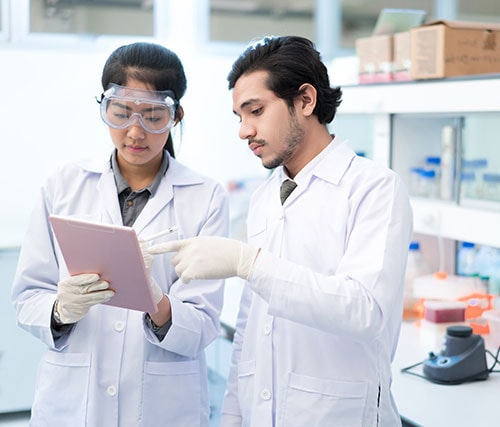Occupational Exposures
Most mothers who work around chemicals can safely breastfeed their babies. The benefits of breastfeeding outweigh the potential risk of exposure to common toxicants through breast milk for most infants. Mothers should try to reduce or eliminate their exposure to occupational toxicants as much as possible while breastfeeding. Employers should provide mothers with information about and training on their potential occupational exposures.
These are some examples of occupational exposures that breastfeeding mothers may be exposed to at work. Employers should work with mothers to reduce possible exposure to occupational toxicants as much as possible.
Working with Chemotherapy Drugs
Many chemotherapy drugs used to treat cancer are cytotoxic at very low doses. Some antineoplastic (chemotherapy) drugs are carcinogens with no known safe level of exposure, so it’s best to reduce or eliminate exposure as much as possible. Employers should provide all workers, including breastfeeding mothers, with information about the chemicals they work with and training on safe work practices. For more information see the Occupational Safety & Health Administration’s (OSHA) Hazard Communication Standard. For more information on working with chemotherapy, visit The National Institute for Occupational Safety and Health’s (NIOSH) page on antineoplastic (chemotherapy) drugs.
For breastfeeding mothers exposed to chemotherapy drugs at work, learn more about reducing occupational exposure.
Working in Dry Cleaning Facilities
Perchloroethylene (PCE) is the most used solvent in dry cleaning facilities. PCE is also known as PERC, perchlor, and tetrachloroethene. Studies show that PCE can enter breast milk. Greater amounts can be found in the breast milk of women exposed to higher amounts of PCE over longer periods of time. Few studies have looked at the effects of PCE on nursing infants, however there are reports on neurological responses and perc exposure in children.
For mothers working in a dry cleaning facility, OSHA has information on reducing your exposure to PCE [PDF-938KB].
Working with Ionizing Radiation
Working near diagnostic X-ray sources does not affect breast milk. Receiving an X-ray also does not affect breast milk.
However, workers who handle radioactive materials, such as radioisotopes in health care and laboratories, or radioactive waste, need to take precautions to reduce exposure. Additional information can be found on NIOSH’s topic page on ionizing radiation.
Workers can also speak with their workplace radiation safety officer, or the state’s department of radiation protection, if they have concerns.
Working in Laboratories

Laboratory work, in either clinical or research laboratories, can involve potential exposure to a wide range of chemicals and agents such as solvents, formaldehyde, ionizing radiation, and infectious agents. Because some chemicals used in laboratories can enter breast milk, breastfeeding mothers who work with chemicals should talk to their health care provider and employer about how to reduce exposure as much as possible.
Lab workers should:
- Follow recommended best practices when handling infectious materials and chemicals,
- Make sure they are using appropriate biological and chemical safety cabinets correctly, and
- Check the Safety Data Sheets (SDS) for chemicals they handle to make sure they are wearing appropriate personal protective equipment (PPE).
Not all gloves or other types of PPE provide adequate protection for all chemicals, thus it is important to match the type of PPE to the type of chemical. If appropriate, local exhaust ventilation, such as fume hoods, exhaust ducts, and exhaust fans should be in place.
Working in Nail, Hair, and Beauty Salons
Nail, hair, and beauty salon employees are potentially exposed to many different chemicals including acrylates (epoxies or resins), solvents, formaldehyde, and biocides as dusts or vapors. Some chemicals commonly used in salons can enter breast milk or be carried home on skin, clothes, and shoes. There are ways to reduce or eliminate exposure to these chemicals at work. Learn more about working in nail, hair, and beauty salons and how to prevent take-home exposures.
Working in Veterinary and Animal Care Services
Veterinary workers may be exposed to several potentially hazardous chemicals and agents such as antineoplastic drugs, antiviral drugs, anesthetic gases, disinfectants, and pesticides, such as those used for flea and mite treatments. Zoonotic infections, or infections acquired from animals should be evaluated individually to determine breastfeeding safety. There are ways to reduce or eliminate exposure to these chemicals and other hazards at work. Learn more about veterinary safety and health and workplace controls.
Using Personal Protective Equipment to Reduce Hazardous Chemical Exposures at Work
A workplace-specific hazard assessment should be conducted to determine potential workplace exposures and which types of controls are needed to reduce those exposures. Controlling exposures to occupational hazards is the fundamental method of protecting workers. However personal protective equipment (PPE) is one method of workplace control. PPE is equipment that is worn to reduce exposure to hazardous chemicals and other workplace hazards. Gloves, protective clothing, goggles, and respirators are types of PPE. The type of PPE needed is determined by the specific chemicals and other hazards in a mother’s workplace. PPE must also be worn and maintained correctly, or else it might provide little or no protection. PPE may reduce exposure to chemicals but does not eliminate it completely. Breastfeeding mothers should talk to their employer about the types of PPE recommended for their work. To learn more about PPE, visit NIOSH’s website on Reproductive Health and The Workplace.
Learn More
- Promoting Worker Well-Being Through Maternal and Child Health: Breastfeeding Accommodations in the Workplace—CDC
- Reproductive Hazards of the Workplace—MotherToBaby
- Reproductive Health and the Workplace: Take-Home Exposures—NIOSH
- The Effects of Workplace Hazards on Female Reproductive Health—NIOSH
- Breastfeeding and Your Job – NIOSH—NIOSH
- Reproductive Hazards—OSHA
